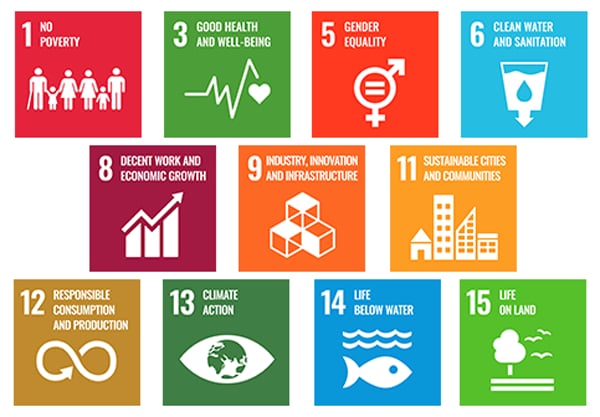Human Potential
The Power of Youth to Create the Next Great Sustainable Business
The United Nations’ 17 Sustainable Development Goals (SDG) serve as a compass that points toward a more prosperous world. To reach that destination, corporate research and development departments and startups globally are toiling to solve the immense sustainability problems the U.N. has identified. Even with all these resources, not all the answers will come from research hubs at multibillion-dollar enterprises or tech unicorns.
Universities often fund the basic research that fuels innovation and futuristic concepts that are not yet scalable. The resources are increasingly immense: Venture capitalist John Doerr and his wife, Ann, recently donated $1.1 billion to Stanford University to fund a school dedicated to solving sustainability and climate change challenges. However, creative and valuable solutions are often developed by students with rich ideas and limited resources. Google emerged from a postgraduate research project at Stanford University, and the idea for FedEx was developed in a Yale University student’s term paper.
On Earth Day 2022 — April 22 — five teams of students from the University of Texas at Dallas presented their ideas, focused on solving important yet seemingly intractable sustainability problems. The contest finalists emerged from a pool of 200 plus students on more than 45 teams that spent months honing their proposals. Each project was designed to be both financially viable and address one or more SDGs.
Figure 1. U.N. SDGs addressed by finalists

Source: Infosys
The competition — organized by the Naveen Jindal School of Management — included plans to reduce packaging and plastic waste and support India’s rural economy. Infosys, one of the contest sponsors, held design thinking workshops and helped the students develop their business plans in line with the spirit of practical sustainability.
The winning team, Biostica, and its sustainable packaging solution was chosen by a panel of judges that included Infosys executive vice president Tan Moorthy. “There was creativity. There was pragmatism in the ideas,” Moorthy said. “The fact that students not only came up with these ideas but also had a business plan on how to make it profitable was very heartening. It’s not only something that they want to do, but it is something that they can do.”
The three members of the Biostica team — Parth Hetal Parikh, Yash Shah, and Atul Meleth — developed fully compostable food and drink containers, which could replace plastics that can’t be recycled economically. The team’s goal is to reduce the production of single-use plastic containers and packaging, which contribute to air, water, and land pollution through their production or disposal. These plastics also injure and kill birds and marine life and leach harmful chemicals into the ground and water.
There is already a multibillion-dollar sustainable packaging industry in the U.S., but the Biostica team argued that most biodegradable packaging has too many downsides. It is not cost-effective, not locally sourced, and often not successful at reducing waste. In many cases, the packaging must be sent to industrial composting facilities or is buried in a landfill without the oxygen needed to break down the material.
In contrast, the Biostica products can fully biodegrade safely in a back yard within 90 days, unlike many other sustainable alternatives. The Biostica packaging uses a coating that is approved by the U.S. Food and Drug Administration for use with food and drink but still allows it to be fully compostable. The team proposes baking a mixture of fibers and food starches to create the containers at 11,000-square-foot production facilities located close to customers. The packaging can also use a variety of agricultural products, including corn starch and sugar cane. This proposal spreads out job creation, reduces transportation costs, lowers the environmental impact, and lessens the risk of supply chain disruption.
The contest’s other top finishers addressed two other sets of problems — one happening thousands of miles away, and one focused on campus.
The five members of the Agriscape LLC team — Ishwari Milind Gondkar, Parth Kulkarni, Smita Singh, Krishna Bezawada, and Mahesh Jajoo — presented a plan to develop agricultural tourism in India. The business would give urban Indians an opportunity to gain new experiences while also supporting rural economies with new streams of income and job opportunities.
The third-placed team, Slate Haircare & Hygiene, designed on-campus refilling stations for shampoo, conditioner, and soap. This team — Navya Gaddam, Hunter Chan, Kevin Jose, and Niyati Palasamudram — proposed a business that seeks to reduce plastic waste and to make products that are manufactured without harmful chemicals more affordable.
These projects represent the types of problems the students will encounter after graduation and the types of issues that governments and enterprises now struggle to solve.
“It is very good exposure to practical issues that people today deal with,” Moorthy said. “If you are to create solutions for clients, there has to be a sustainability angle to it. For us to be able to do that, we need people who understand and think sustainability.”
The contest was part of UT Dallas’s larger Global Sustainability Experience — an event that featured webinars, workshops, and prominent speakers, including Richardson Mayor Paul Voelker and Nobel Laureate Muhammad Yunus, founder of Grameen Bank and a microcredit and social business pioneer. Yunus encouraged students in the audience to view their youth as an advantage, an opportunity to see fresh solutions that are not yet “contaminated by the old thinking.”
“Today, being young people, you are the most powerful human beings on this planet,” he said, referring to their access to technology. “If you feel you have the power, which an older generation never had, the next question you should ask is, ‘What is the use I am making of this power?’ … Decide what it is that you want to do. That’s the most fundamental question you will ask of yourself.”




